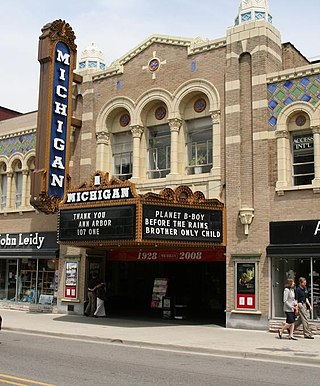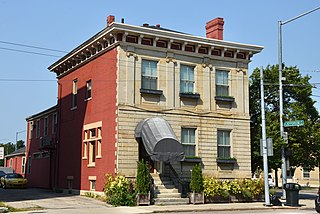
Dayton is the sixth-largest city in the U.S. state of Ohio and the county seat of Montgomery County. A small part of the city extends into Greene County. The 2020 U.S. census estimate put the city population at 137,644, while Greater Dayton was estimated to be at 814,049 residents. The Combined Statistical Area (CSA) was 1,086,512. This makes Dayton the fourth-largest metropolitan area in Ohio and 73rd in the United States. Dayton is within Ohio's Miami Valley region, 50 miles (80 km) north of the Greater Cincinnati area.

The National Museum of the United States Air Force is the official museum of the United States Air Force located at Wright-Patterson Air Force Base, six miles (9.7 km) northeast of Dayton, Ohio. The NMUSAF is the oldest and largest military aviation museum in the world, with more than 360 aircraft and missiles on display. The museum draws about a million visitors each year, making it one of the most frequently visited tourist attractions in Ohio.

The Michigan Theater is a movie palace in Ann Arbor, Michigan, United States, right adjacent to the Central Campus of the University of Michigan. It shows independent films and stage productions, and hosts musical concerts.

The Texas Theatre is a movie theater and Dallas landmark located in the Oak Cliff neighborhood of Dallas, Texas. It gained historical significance on November 22, 1963, as the location of Lee Harvey Oswald's arrest over the suspicion he was the killer of Dallas Police Officer J. D. Tippit. Today, it hosts a mix of repertory cinema and special events.

Huffman Prairie, also known as Huffman Prairie Flying Field or Huffman Field is part of Ohio's Dayton Aviation Heritage National Historical Park. The 84-acre (34-hectare) patch of rough pasture, near Fairborn, northeast of Dayton, is the place where the Wright brothers undertook the difficult and sometimes dangerous task of creating a dependable, fully controllable airplane and training themselves to be pilots. Many early aircraft records were set by the Wrights at the Huffman Prairie.

Carillon Historical Park is a 65-acre park and museum in Dayton, Ohio, which contains historic buildings and exhibits concerning the history of technology and the history of Dayton and its residents from 1796 to the present. As a part of the University of Dayton, the historical elements of the park were the brainchild of Colonel Edward Deeds. The major sections include settlement, transportation, invention, and industry. The park also contains the Carillon Park Railroad, a 7+1⁄2 in gauge miniature railway.

Dayton Aviation Heritage National Historical Park is a United States National Historical Park in Dayton, Ohio that commemorates three important historical figures—Wilbur Wright, Orville Wright, and poet Paul Laurence Dunbar—and their work in the Miami Valley.

The Howard Theatre is a historic theater, located at 620 T Street, Northwest, Washington, D.C. Opened in 1910, it was added to the National Register of Historic Places in 1974.

The Victoria Theatre is a historic 1,154-seat performing arts venue located in downtown Dayton, Ohio. The Victoria presents traveling broadway shows, concerts and other theatrical productions such as The Phantom of the Opera.

The Rentschler House is a historic residence in the city of Hamilton, Ohio, United States. Constructed at the turn of the 20th century, it has been named a historic site.

The Dayton, OH Metropolitan Statistical Area, also known as Greater Dayton and the Miami Valley, as defined by the United States Census Bureau, is an area consisting of three counties in the Miami Valley region of Ohio and is anchored by the city of Dayton. As of 2020, it is the fourth largest metropolitan area in Ohio and the 73rd largest metropolitan area by population in the United States with a population of 814,049.

The James Brooks House is a historic house in downtown Dayton, Ohio, United States. Built in the 1830s and significantly modified later in the century, it was named a historic site in the 1970s.

Dr. Jefferson A. Walters House is a historic residence in downtown Dayton, Ohio, United States. Built in 1832 and one of the city's older houses, it was home to two prominent residents of early Dayton, and it has been named a historic site.

The Brick Tavern House is a former inn on the National Road west of St. Clairsville, Ohio, United States. One of the oldest National Road taverns still in existence, it was built in the early nineteenth century. Although it fell into dilapidation during the late twentieth century, it was named a historic site in 1995, and extensive restoration was to be performed in the early 2010s but to date, has not been.

The Dayton Fire Department Station No. 16 was a historic fire station on the near east side of Dayton, Ohio, United States. An architectural landmark constructed in the early twentieth century, it was named a historic site seventy years after being built, but it is no longer extant.

The Mississippi Lofts and Adler Theatre is an apartment building and theater complex located in downtown Davenport, Iowa, United States. It is individually listed on the National Register of Historic Places by its original name, the Hotel Mississippi and RKO Orpheum Theater. The Hotel Mississippi was listed on the Davenport Register of Historic Properties in 2005. In 2020 the complex was included as a contributing property in the Davenport Downtown Commercial Historic District.

The Jamestown Opera House is a historic government building and community center in the village of Jamestown, Ohio, United States. It has been named a historic site because of its well-preserved architecture. Besides serving as a theater, the opera house has functioned as the community's village hall, its fire station, its post office, and its library.

The Mercer Log House is a large log cabin in the city of Fairborn, Ohio, United States. Home to the city's first settlers and changed very little since their time, it is one of Ohio's best preserved log cabins from the settlement period, and it has been named a historic site.
Liebenberg and Kaplan (L&K) was a Minneapolis architectural firm founded in 1923 by Jacob J. Liebenberg and Seeman I. Kaplan. Over a fifty-year period, L&K became one of the Twin Cities' most successful architectural firms, best known for designing/redesigning movie theaters. The firm also designed hospitals, places of worship, commercial and institutional buildings, country clubs, prestigious homes, radio and television stations, hotels, and apartment buildings. After designing Temple Israel and the Granada Theater in Minneapolis, the firm began specializing in acoustics and theater design and went on to plan the construction and/or renovation of more than 200 movie houses throughout Minnesota, North and South Dakota, Iowa, and Wisconsin. Architectural records, original drawings, and plans for some 2,500 Liebenberg and Kaplan projects are available for public use at the Northwest Architectural Archives.





















